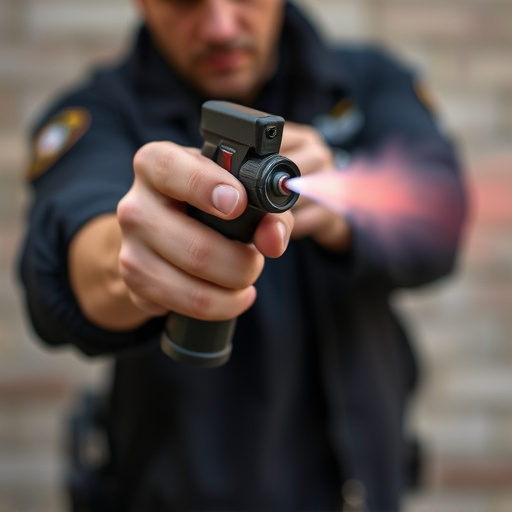Pepper spray equipment, specifically oleoresin capsicum (OC) spray, is a vital tool for law enforcement, but its use requires proper training and understanding. The Pepper Spray Eye Washing Procedure is a critical step to mitigate discomfort and potential eye damage after exposure. This procedure involves positioning the affected individual comfortably, providing clean water access, encouraging blinking, and rinsing eyes gently for at least 15 minutes while communicating reassurance. Law enforcement officers must undergo detailed training on pepper spray types, effects, and proper handling, including regular drills to ensure safe and effective deployment.
“In the dynamic field of law enforcement, equipping officers with effective non-lethal force tools is paramount. Among these, pepper spray stands out as a powerful deterrent and crowd control measure. This article delves into the essential aspects of law enforcement pepper spray equipment, focusing on its types, components, and most crucially, the Pepper Spray Eye Washing Procedure. By understanding these key elements, officers can ensure safe and effective deployment while adhering to best practices in eye washing.”
- Understanding Pepper Spray Equipment: Types and Components
- Pepper Spray Eye Washing Procedure: Steps and Best Practices
- Safety Considerations and Training for Law Enforcement Officers
Understanding Pepper Spray Equipment: Types and Components
Pepper spray equipment is a critical component of law enforcement officers’ tools, designed to subdue and control individuals in various high-risk scenarios. Understanding the different types and components of this equipment is essential for both officers and those tasked with their maintenance. There are several varieties, each serving specific purposes, such as oleoresin capsicum (OC) spray, which is the most common form. These devices typically consist of a canister containing OC, a nozzle for spraying, and a trigger mechanism that controls the release of the chemical agent.
The pepper spray eye washing procedure is a crucial safety measure after its use. It involves flushing the eyes with clean water for at least 15 minutes to dilute and wash away the irritant. Proper maintenance and familiarity with the equipment’s functionality are vital, ensuring officers can deploy it effectively while minimizing risks associated with chemical exposure.
Pepper Spray Eye Washing Procedure: Steps and Best Practices
Pepper Spray Eye Washing Procedure: Steps and Best Practices
When responding to situations involving pepper spray, effective eye washing is crucial for immediate relief and to prevent prolonged discomfort or potential damage. The Pepper Spray Eye Washing Procedure involves several steps designed to flush out irritants swiftly and safely. Start by positioning the affected individual in a comfortable, seated position with their head slightly inclined forward. Ensure access to clean, flowing water—preferably under gentle pressure—as it’s key to thorough cleansing.
Gentle but thorough blinking should be encouraged while slowly opening and closing the eyes to help dislodge any remaining pepper spray residue. After initial flushing, continue washing for at least 15 minutes, ensuring all eye areas are thoroughly rinsed. Use clean towels or soft cloth materials to gently blot dry the eyes, avoiding rubbing which could exacerbate irritation. Throughout the process, communicate with the individual, providing reassurance and monitoring their comfort level to ensure the best practices in pepper spray eye washing are followed.
Safety Considerations and Training for Law Enforcement Officers
Law enforcement officers using pepper spray must be well-trained and aware of safety considerations to ensure its effective deployment while minimizing risks. Before utilizing this equipment, officers should undergo comprehensive training on proper handling, including understanding the different types of pepper spray, their strengths, and how they affect the human body. This knowledge is crucial for making informed decisions during high-pressure situations.
Training should also cover the pepper spray eye washing procedure, as exposure to the eyes can cause significant discomfort and temporary blindness. Officers must learn the correct techniques to irrigate the eyes thoroughly with clean water and seek medical attention if symptoms persist. Regular drills and simulations help officers maintain proficiency, ensuring they react calmly and safely when confronted with scenarios requiring the use of pepper spray.
Law enforcement pepper spray equipment plays a vital role in ensuring officer safety and effective crowd control. Understanding the various types, components, and proper usage of this equipment is crucial. The detailed discussion on the pepper spray eye washing procedure highlights the critical steps and best practices for immediate care after exposure. Additionally, focusing on safety considerations and thorough training equips officers with the knowledge to handle these situations responsibly. By adhering to these guidelines, law enforcement agencies can maximize the benefits of pepper spray while minimizing risks, thereby enhancing operational efficiency and officer well-being.
